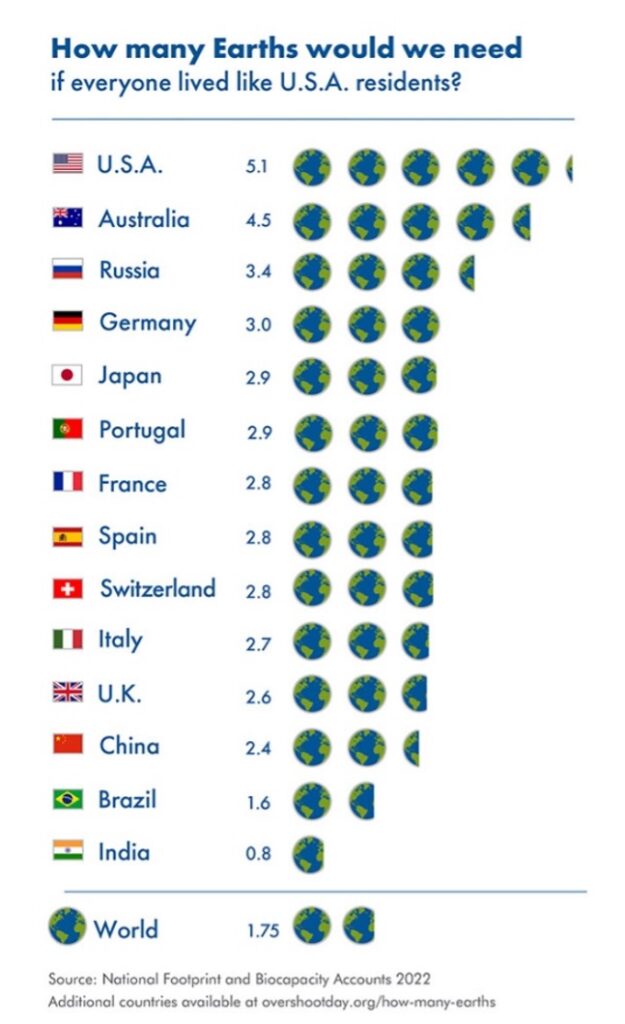There is an interesting ongoing analysis conducted by the Global Footprint Network that monitors the yearly Earth Overshoot Day. Humanity is currently using Earth’s natural resources 1.7 times faster than our planet’s biocapacity regeneration capacity. However, not all the countries are homogeneously using the same nature’s capacity. Developed countries like U.S.A or Australia “needs” lead to more consumption compared to developing countries like India, which despite amounting for a roughly 20% of the global population, it only needs 0.8 Earths allowing our planet to regenerate.
Do we imply that one country should emulate the culture and lifestyle of other country? Absolutely not. Each country’s society is different, its climate and environment define the way it lives. Cultural diversity should remain as it adapts to the conditions of their environment. However, our global society needs to learn to use all our limited resource efficiently. The adoption of a Circular Economy is key to achieve maximum resource utilization efficiency.

Circular economy is the systemic approach to economic development designed to benefit businesses, society, and the environment. In contrast to the ‘take-make-waste’ linear model, the circular economy is regenerative by design and aims to gradually decouple growth from the consumption of finite resources.
If you are reading this article is because you would like to leverage the benefits of the circular economy for your business, but you also want to make sure you do not put your business at risk jumping blindly without careful planning and assessment. Each organization is different. Size, nature of the business, scope, locality, and many other factors that will determine the context of your organization. Based on that context, you will have to determine the best steps to take to integrate circularity in your business.
How can businesses integrate the Circular Economy Principles into their Business as Usual?
The reality is that there is no “one-answer-fits-all” solution. Instead, companies need to approach Circular Economy using “Management of Change” processes in a systematically staged manner.

The process is triggered by the identified need of integrating Circularity into the business. This need might come from a shareholder, a stakeholder, a client, a customer, employees or even it might have been prompted by the current society requirements. Whenever the need for this change is identified (Vision), the most assuring way to undertake this change is in a systematic manner following a management of change process. For a controlled and calculated risk-change approach the process should go through 6 differentiated stages:
PLANNING
The planning stage is triggered by the identification and appointment of a Champion with enough authority in the company to lead and achieve the Change Programme. This Champion will be tasked with forming a team with differentiated expertise to take the programme to the 2nd stage: Approval.
Once the Teams is formed, it will be tasked with the development of the Change Strategy that will take the business to achieve the Vision “A Business that operates under the Principles of Circular Economy”. The Change Strategy is defined by the consecutive long-term goals roadmap that will take the organization from a Take-Make-Waste model to a Circular model. Since the investment in this change programme will be substantial, the road map must have enough milestones and checkpoints to ensure that the change is taking place in a secure, consistent, and successful manner.
In a simplified way, the Change Strategy exercise consist of the following tasks:

- Define the future Circular BaU,
- Define the current Take-Make-Waste BaU,
- Conduct a gap analysis,
- Define the different milestones that the business needs to achieve to go from Take-Make-Waste to Circular model.
To conduct the gap analysis and define milestones the Team will require to define the context of the organization if the Change is going to be implemented in the entire company or define the context of the business line(s) if the Change will only be implemented partly in the company. As we previously mentioned the context will be defined by the size, nature of business, locality, scope and boundaries of the business subjected to change. This context is the current Take-Make- Waste and should contain as much details as necessary to conduct the gap analysis. In the other hand, the end product “A Business that operates under the Principles of Circular Economy” should also include as much definition as possible, aside of the limitations of the undefinition at this stage of the programme.
Once the milestones have been defined the Team will be tasked with the development of a temporary schedule to understand when realistically these milestones can be achieved. At this point, the Team should also provide a high-level mapping of resources needed and a high-level organizational chart.
Next steps will require the involvement of commercial expertise to:
- Calculate the necessary budget and Return on Investment (RoI)
- Conduct risk assessment to calculate the inherent risk
Once all the tasks have been completed, the Team will assemble a Management of Change Program Package to submit to the Executive for approval. This package will consist of:
- A Technical section defining current stage, context and the end product. It will also provide the differentiated sequence of milestones that the programme needs to achieve.
- A Programme Controls section which will include a temporal schedule with necessary checkpoints, a high-level mapping of resources and the organizational structure. This section will also contain a description on how the programme is planned to be achieved and definition of different projects that the programme consists of, if turnkey phase at established stages is needed. The proposed Project Director is also normally provided at this stage.
- A Commercial section which will include investment, risk and opportunities, and return on RoI.
This package will be reviewed by the Champion prior to submittal to the Executive.
APPROVALs
The Executive will review the package and either, approve it and trigger the next stage, Execution, or request necessary amendments. If amendments are required, the package will be returned to the Management of Change Champion who will amend as necessary and resubmit for final approval.
Once the approval is granted, the investment is locked as per details described in the commercial section of the package.
PROJECT EXECUTION
This phase is activated with the appointment of the Project Director. The Project Director is responsible for taking the project from design through implementation to commissioning. The Project Director is accountable for the successful completion of the project and has got necessary authority to make the required decisions (within the budget ±tolerance) to keep the project moving to achieve the goal.
The Project Director will also be responsible for forming the Team that will execute the project.
DESIGN
The design phase of the project is staged in the below steps:
The detailed definition of the necessary requirements that the company will need to run the Circular BaU. This includes:
- Identification of the competencies necessary to run the Circular BaU. When implementing circularity in your business, consideration should be given at the different departments that would be involved, the knowledge and skills that will be necessary depending on the nature of the business.
- Identification of the necessary equipment and tools to run the Circular BaU. Again, depending on the nature of your business, those could constitute of machinery and software.
- Identification of necessary policies, procedures and plans required to run the Circular BaU. Once more these will be tailored to the nature of your business. There is no right or wrong answer here. These shall be suited to the culture of the organization.
This design phase is particularly important, and it is recommended to design with the Circular Economy Principles in mind, which can be summarized in the below simple rules:
- Designing out waste from your products and services.
- Designing products with the easiness of replacing parts that fail or wear off as necessary.
- Designing products with end-of-life material recovery in mind.
- Diverting materials out of the waste process.
- Finding new markets for generated waste (by-products).
- Engaging with suppliers and vendors who utilise recycled materials in their products.
- Engaging with suppliers and vendors with product end-of-life (EOL) return service.
After defining the “What, Where, When, Who and How” that will run the Ciruclar BaU, the Project Team will conduct a gap analysis that will dictate the extend of transformation that the organization (or business) will require to go from the current Take-Make-Waste BaU to the Circular BaU.
The gap analysis will define the training needs required to upscale competencies, the facilities upgrade that are needed to accommodate the recirculation of materials, and necessary IT technology involved. It will also define any new roles that might be created at all organizational levels.
IMPLEMENTATION
The Implementation phase is defined by the “DO actions”. The Team will ensure that all the activities planned during design phase are conducted as per the design requirements.
These involves:
- Obtaining competency requirements,
- Developing knowledge materials,
- Outsourcing trainings,
- Working with Human Resources for the staffing of the new roles,
- Conducting any facilities refurbishment,
- Connecting necessary IT technologies,
- Updating the organizational structures of the future Circular BaU,
- Developing the policies, processes, procedures, plans and work instructions required to integrate circularity.
One additional note to consider would be that if your company has got different business lines or operational units, the programme / project might need to be repeated and / or adjusted for each individual unit. You might want to consider different management of change for each unit or you might want to consider management of change of one unit at the time and roll it out for the rest of your units one-by-one with necessary adjustments. All depends on how different your lines of business are. You might decide to take the inherent risks on one operational unit to be able to buffer in case RoI is not as planned, lowering your overall enterprise risk.
COMMISSIONING
The Commissioning Stage, the Team is tasked with the roll-out of trainings to the involved personnel within the company to ensure the expected performing of the future Circular Business-As-Usual.
Further, instead of cold launching any changes into the working environment it is recommended to run an implementation testing period to troubleshoot all possible shortfalls and errors. This testing period not only applies to the refurbished facilities but also to IT technology and software, procedures and work instructions, and even conducting competency assurance on personnel. During this testing period, any findings shall be noted down and corrected as appropriate.
The testing period would normally take between 1 and 3 months depending on the expend of the Change Project. The Project Team would also have defined in a Commissioning Plan how the Change would be rolled out, either all at once or in small stages. Remember, there is no right or wrong when rolling-out the changes. However, this plan must be approved by the Management of Change Champion.
Once the performance of the testing period is satisfactory, it is time to enter into the Operation stage, as the new Circular BaU.
FOLLOW-UP
The first year in the new Circular BaU, it is recommended to conduct close monitoring of performance. It serves as a baseline for future Strategy and Goals, but it is also required to confirm the expected RoI. This period is not free from challenge. Since not all the company personnel might had been involved during the commissioning stage, there is still plenty of work promoting the new BaU within the rest of the company, outside the company with clients and customers, and also with suppliers, vendors and subcontractors.
The success during this period is crucial and the aim is to make sure the change sticks, otherwise, your employees might feel returning to their old ways or doing business. Techniques to persuade employees to continue pushing might be aligned with positive reinforcement practices, using recognition certificates, promoting results and even monetary bonuses.
Any deviations from RoI must be recorded and analysed accordingly. The results from the analysis will require review from the Management of Change Champion and if any recommendations have been made during this assessment, they should be considered for adjustment, as necessary.
The Follow-up stage will continue running as long as the RoI stipulated. This could had been fixed to a 5 year period. It is recommended that during the Follow-up period periodical performance reports are issued to Executive.
CLOSURE
Once the RoI is achieved, the Management of Change Programme can be formally closed. This should involve a Final Performance Report which should also cover any Lessons Learnt gained during this programme.
The main take is that there is no right or wrong. Each organization is different by size, nature of business, locality, culture, surroundings, and business relationships. Hence, there is no one solution that fits all. What might work for one company, one business line, it might be a failure when we try to emulate into another work environment.
If you are not sure, seek professional services to help you and your company get through this change successfully.
Did you find this post interesting? Please leave us your comments. We would like to hear from you and improve our content to better serve you!
Footnote: Image Credits

